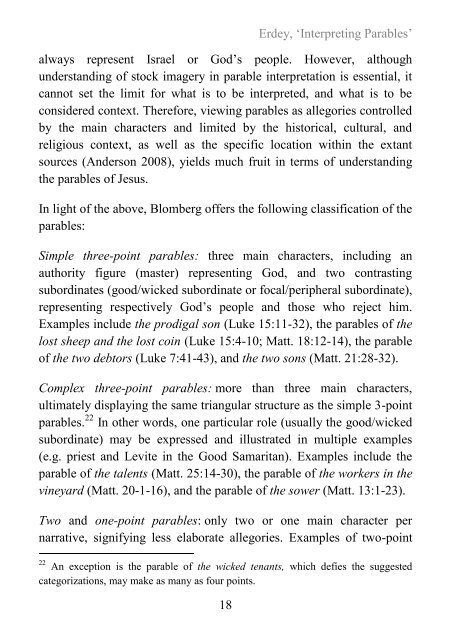Conspectus, vol. 10.pdf - South African Theological Seminary
Conspectus, vol. 10.pdf - South African Theological Seminary
Conspectus, vol. 10.pdf - South African Theological Seminary
Create successful ePaper yourself
Turn your PDF publications into a flip-book with our unique Google optimized e-Paper software.
18<br />
Erdey, ‘Interpreting Parables’<br />
always represent Israel or God’s people. However, although<br />
understanding of stock imagery in parable interpretation is essential, it<br />
cannot set the limit for what is to be interpreted, and what is to be<br />
considered context. Therefore, viewing parables as allegories controlled<br />
by the main characters and limited by the historical, cultural, and<br />
religious context, as well as the specific location within the extant<br />
sources (Anderson 2008), yields much fruit in terms of understanding<br />
the parables of Jesus.<br />
In light of the above, Blomberg offers the following classification of the<br />
parables:<br />
Simple three-point parables: three main characters, including an<br />
authority figure (master) representing God, and two contrasting<br />
subordinates (good/wicked subordinate or focal/peripheral subordinate),<br />
representing respectively God’s people and those who reject him.<br />
Examples include the prodigal son (Luke 15:11-32), the parables of the<br />
lost sheep and the lost coin (Luke 15:4-10; Matt. 18:12-14), the parable<br />
of the two debtors (Luke 7:41-43), and the two sons (Matt. 21:28-32).<br />
Complex three-point parables: more than three main characters,<br />
ultimately displaying the same triangular structure as the simple 3-point<br />
parables. 22 In other words, one particular role (usually the good/wicked<br />
subordinate) may be expressed and illustrated in multiple examples<br />
(e.g. priest and Levite in the Good Samaritan). Examples include the<br />
parable of the talents (Matt. 25:14-30), the parable of the workers in the<br />
vineyard (Matt. 20-1-16), and the parable of the sower (Matt. 13:1-23).<br />
Two and one-point parables: only two or one main character per<br />
narrative, signifying less elaborate allegories. Examples of two-point<br />
22 An exception is the parable of the wicked tenants, which defies the suggested<br />
categorizations, may make as many as four points.

















